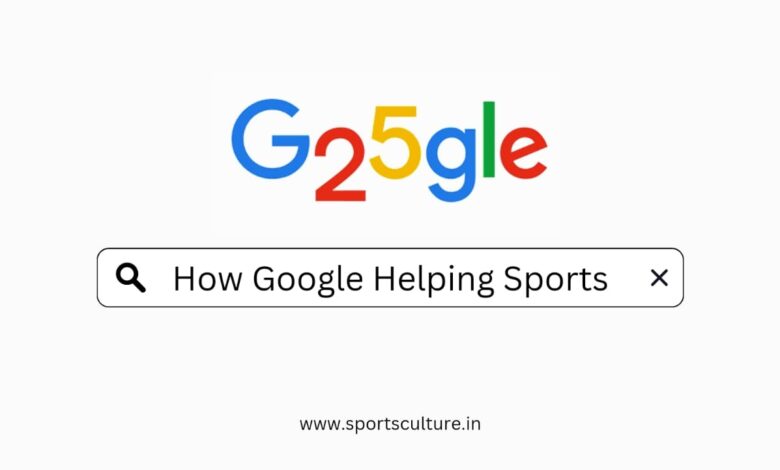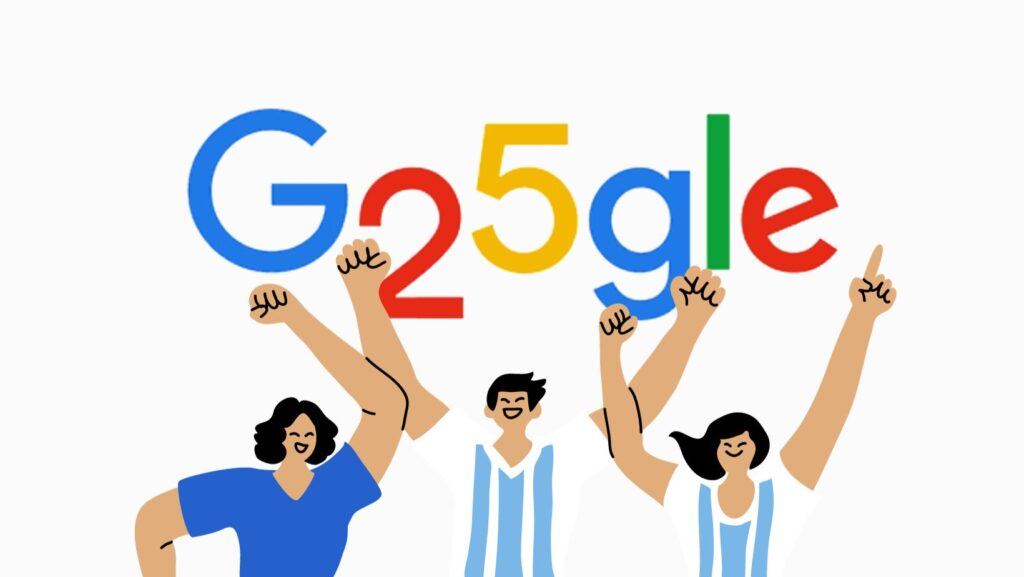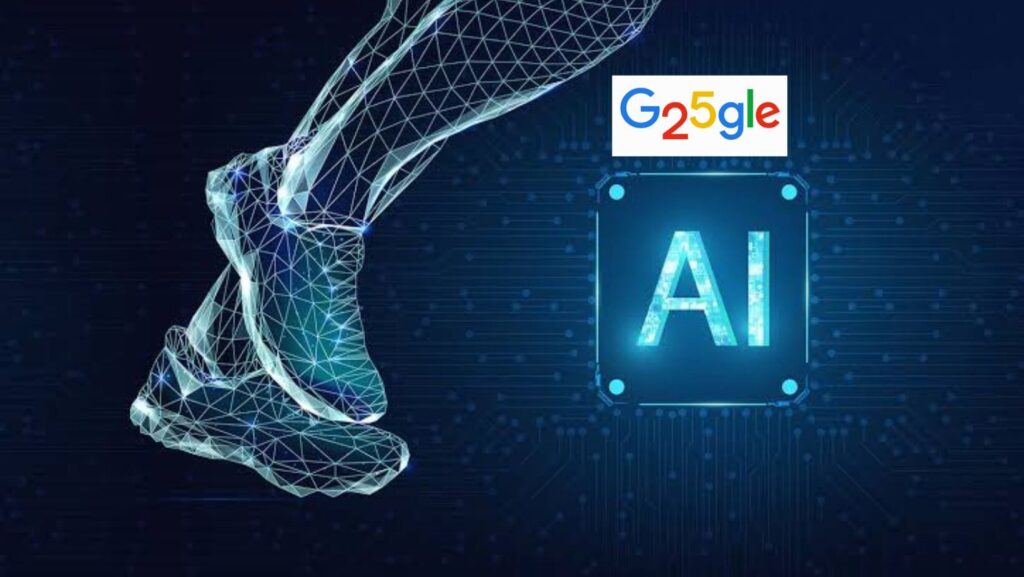Exploring How Google Helping Sports: Google’s 25th Anniversary

On Google’s 25th Anniversary Sports Culture is exploring how Google is helping sports throughout the world and what are are it’s impact on it.
How Google is Helping Sports as an Industry
Google plays a significant role in the world of sports through various services and technologies that benefit athletes, sports organizations, and fans. Here are some ways in which Google is helping various sports like Cricket, Football etc.:
Search and Information: Google Search provides a vast repository of information about sports, including live scores, schedules, player profiles, and historical data. Fans can easily find the latest updates and statistics for their favorite teams and players.
Google Maps: Google Maps is used by sports enthusiasts to navigate to stadiums, arenas, and sports venues. It provides real-time traffic information, public transportation options, and directions to make it easier for fans to attend events.
YouTube: YouTube, owned by Google, is a major platform for sports content. Fans utilizes this platform to watch highlights, interviews, and even full games also podcasts. Many sports organizations and athletes have their own YouTube channels to engage with fans.
Google Cloud: Google Cloud offers cloud computing and data analytics solutions that are used by sports teams and organizations for various purposes. This includes analyzing player performance data, managing ticketing and fan engagement, and optimizing operations.
Google Assistant: Google Assistant provides sports fans with real-time updates on scores, game schedules, and player statistics through voice commands or text queries. Users can also set up personalized sports news alerts.
Advertising and Sponsorships: Google’s advertising platforms, such as Google Ads and YouTube Ads, are used by sports organizations to reach their target audiences and promote events, merchandise, and ticket sales. Google also engages in sponsorship deals with sports teams and events.
Virtual Reality (VR) and Augmented Reality (AR): Google has invested in VR and AR technologies that can enhance the sports viewing experience. This includes applications like Google Cardboard for VR and AR apps that provide immersive experiences for fans.
Google Fit: Google Fit is a fitness and health tracking platform that can be used by athletes to monitor their training and performance. It can sync with various fitness devices and apps to provide a comprehensive view of one’s health and fitness.
Google Trends: Google Trends offers insights into what sports and teams are trending at any given time. This can be valuable for sports marketers, advertisers, and media outlets to tailor their content to current interests.
Google Workspace: Sports organizations often use Google Workspace (formerly G Suite) for communication and collaboration. It includes tools like Gmail, Google Drive, and Google Meet, which facilitate efficient teamwork and organization within sports teams and leagues.
Data Analytics: Google’s data analytics tools, such as BigQuery and Data Studio, can be employed by sports organizations to analyze vast amounts of data related to player performance, fan engagement, and business operations.
Google Earth: Google Earth provides detailed 3D maps and satellite imagery that can be utilized by sports teams and event planners for venue selection, logistics planning, and visual presentations.
Google contributes to the world of sports by providing information, technology solutions, advertising platforms, and tools that enhance the fan experience, aid sports organizations in their operations, and support athletes in their training and performance analysis.
How Google is Helping Sports Fans

Google has revolutionized it’s SERP (Search Engine Results Page) to give the sports fans more sorted and complete sports update interface so that they can get all the updates in more efficient way. In a brief Google’s Search Engine Results Page (SERP) snippet evolution has significantly changed the way match results are monitored by the masses. Here’s how:
Quick Access to Scores: Google’s SERP now often displays real-time scores and match results at the top of the search results page. Users no longer need to click on links to dedicated sports websites or apps to find the latest scores. This provides quick and convenient access to sports information.
Convenience for Mobile Users: With the increasing use of mobile devices, Google’s SERP snippets have become mobile-friendly. Users can easily check scores and match updates on their smartphones without having to visit multiple websites or apps.
More Contextual Information: Google’s snippets provide not only scores but also additional context, such as upcoming fixtures, team standings, and player statistics. This comprehensive information is useful for fans who want to stay informed about their favorite sports.
Simplified Querying: Google has improved its natural language processing capabilities, allowing users to make complex sports-related queries in plain language. For example, users can ask, “When is the next game for the Lakers?” and receive accurate and relevant information.
Integration with Google Assistant: Google Assistant, integrated with SERP snippets, enables users to get sports updates using voice commands. This hands-free interaction is convenient for users who are on the go or multitasking.
Real-Time Updates: Google’s snippets often provide real-time updates during live matches, including play-by-play summaries and key events. This feature is particularly valuable for fans who cannot watch the game live.
Highlighting Key Moments: Google may highlight significant moments in a match, such as goals, touchdowns, or home runs, within the snippet. This allows users to quickly identify the most important events in a game.
Video Highlights: In some cases, Google’s SERP snippets include video highlights from matches. Users can watch key moments directly on the search results page without having to visit separate video platforms or sports websites.
Rich Visuals: Google’s snippets may feature rich visuals, such as team logos, player photos, and event graphics, making the search experience more engaging and visually appealing.
Overall, Google’s SERP snippet evolution has made it easier and more convenient for sports enthusiasts to monitor match results, access relevant information, and stay updated on their favorite teams and events. It has transformed the way people consume sports-related content online, prioritizing speed and accessibility.
What else Google can do to help Sports in Future!

Google’s continued involvement in sports can bring about further improvements through the integration of artificial intelligence (AI) and other innovative technologies. Here are some additional ways in which Google can enhance the world of sports using AI and other means:
AI-Powered Predictive Analytics: Google can develop AI models that use historical data and real-time inputs to predict match outcomes, player performance, and injury risks. This could provide valuable insights for sports teams, coaches, and fans.
Player Performance Analysis: AI-driven computer vision can analyze video footage of matches to provide detailed player performance metrics. This can help coaches and analysts identify strengths, weaknesses, and areas for improvement in individual players.
Injury Prevention: AI can be used to analyze biomechanical data from athletes to detect potential injury risks. Athletes can receive personalized recommendations for training adjustments and recovery strategies to reduce the likelihood of injuries.
Virtual Reality Training: Google can develop VR training platforms that allow athletes to simulate game situations, improving decision-making, spatial awareness, and reaction times.
Fan Engagement: AI-driven chatbots and virtual assistants can enhance fan engagement by providing personalized updates, responding to queries, and offering virtual experiences like tours of stadiums or interactive fan challenges.
Enhanced Viewing Experiences: Google could further develop AR and VR technologies to provide immersive viewing experiences for fans. This might include 360-degree camera views, augmented reality overlays, and interactive replays.
Language Translation: Google’s AI can aid in breaking language barriers by offering real-time translation services for international sports events. This enables fans from diverse backgrounds to enjoy sports content in their preferred language.
Fan Behavior Insights: AI can analyze fan behavior data, such as social media interactions and ticket purchases, to help sports organizations better understand their fan base and tailor marketing and fan engagement strategies accordingly.
Enhanced Data Visualization: AI-driven data visualization tools can make complex sports statistics and analytics more accessible to coaches, analysts, and fans, aiding in decision-making and strategy development.
Youth Development: AI can assist in talent identification and development at the grassroots level by analyzing performance data of young athletes and providing guidance to coaches and parents.
Athlete Mental Health: AI-driven mental health support tools can be developed to help athletes manage stress, anxiety, and performance pressure. These tools can offer personalized coping strategies and resources.
Accessibility: Google can continue to improve accessibility features for sports content, making it easier for individuals with disabilities to enjoy sports through voice commands, screen readers, and other assistive technologies.
By harnessing the power of AI and innovative technologies, Google has the potential to revolutionize various aspects of the sports industry, from athlete performance to fan engagement, and contribute to the overall growth and advancement of sports worldwide.


